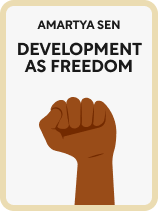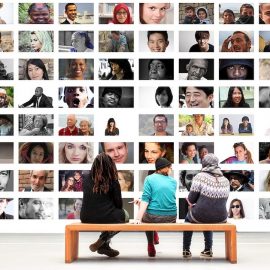

This article is an excerpt from the Shortform book guide to "Development as Freedom" by Amartya Sen. Shortform has the world's best summaries and analyses of books you should be reading.
Like this article? Sign up for a free trial here .
What are the types of freedom, according to Amartya Sen? Why is it important for governments to support and instill these types of freedoms into their countries?
In Development as Freedom, Amartya Sen makes a philosophical case that freedom-centered development can create a better society and economy. The types of freedom that are essential for a person’s potential are democratic rights, commercial liberties, public provisions, ethical guardrails, and safety nets.
Check out what Sen believes are the most important freedoms a person should have.
Five Types of Freedom
What are the types of freedom? Sen cites five rights that advance a person’s potential:
- Democratic rights
- Commercial liberties
- Public provisions
- Ethical guardrails
- Safety nets
(Shortform note: Sen’s list of five freedoms is similar to the four freedoms that Franklin D. Roosevelt laid out in a famous speech in 1941. Roosevelt argued the four fundamental freedoms were: freedom of speech, freedom of worship, freedom from want, and freedom from fear. Like Sen, Roosevelt believed it was the government’s obligation to provide material support and national security to people, in addition to securing their liberties.)
#1: Democratic Rights
Sun explains that democratic rights (or political freedoms) are mostly synonymous with the typical civil rights of liberal democracy. They include:
- The ability to choose who governs and on what principles
- The right to freedom of expression and the press
- The right to form and choose among political parties
- The right to criticize authority figures
#2: Commercial Liberties
By commercial liberties, Sen means the freedom of individuals to produce, exchange, and consume their choice of goods and services. Here, Sen focuses on the ability to engage in economic activity free from arbitrary constraints, such as government price controls and forced labor. The right to access financial institutions and credit is also part of economic freedom. This access is crucial because it gives low-income people a chance to earn interest through savings, or to receive loans for new business ventures.
#3: Public Provisions
Public provisions refer to having access to services that enable people to live better—such as education and health care. These provisions allow people to better enjoy other types of freedoms. For example, access to education provides literacy, which is crucial to exercising political freedoms because it allows citizens to make more informed decisions; good health is important to commercial freedom because it allows people to be more productive workers.
#4: Ethical Guardrails
Ethical guardrails create openness and trust in social interactions, especially commerce. According to Sen, ethical guardrails include the “right to disclosure,” or public “right to know,” and other components of business and contract law necessary to prevent government corruption, crooked business practices, and other unethical behavior.
(Shortform note: “Right to disclosure” refers to rules like the SEC’s requirement for publicly traded corporations to release pertinent information about their businesses—such as balance sheets, income statements, and statements of cash flows.)
#5: Safety Nets
The last type of freedom is social safety nets, which guard against severe suffering. Sen distinguishes between fixed institutional arrangements and ad hoc arrangements. Fixed institutional arrangements are programs such as supplemental income and unemployment benefits. Ad hoc arrangements include disaster relief or emergency public employment. Sen believes both types are important components of development.
Major Safety Net Programs in the US
Safety nets as a type of freedom remain a contentious subject among economists and policymakers. Sen argues safety nets are necessary to combat poverty and misfortune, while others argue they provide disincentives to work and fail to improve social mobility for the poor.
During the Great Depression, the federal government established America’s first safety net programs. Since then, programs have been designed or expanded to broaden their reach. Sen considers these programs “fixed institutional arrangements,” and argues they are fundamental to freedom because they fortify people’s capabilities.
The Social Security Act: Passed in 1935, the Social Security Act provides unemployment compensation and is a major source of income for the retired, unemployed, and people with disabilities. It’s currently the largest safety net program in the US, serving about 62 million Americans.
Head Start: Established in 1964, Head Start is a pre-kindergarten education program designed to reduce disparities in educational attainment between rich and poor children. It currently serves around 900,000 primarily low-income kids.
Supplemental Nutrition Assistance Program: Also established in 1964, the Supplemental Nutrition Assistance Program (SNAP), commonly referred to as “food stamps,” provides food vouchers as a means of fighting hunger and food insecurity.
Medicare/Medicaid: In 1965, the US government established Medicare, which provides health insurance to people 65 and over, and Medicaid, which provides coverage to low-income Americans. Combined, more than 100 million people are enrolled in these programs.
Federal Pell Grant Program: In 1972, the Federal Pell Grant Program became law. It provides tuition and other assistance to low-income college students.
Earned Income Tax Credit: The Earned Income Tax Credit (EITC), established in 1975, is a tax credit available to working people of modest income. In 2015, nearly 50 million taxpayers received benefits through the EITC.
The Affordable Care Act: Passed in 2010, the Affordable Care Act subsidizes the private health insurance of low-income people. It also expands Medicaid by offering matching federal funds to states.
In addition to these programs, others provide unemployment insurance, monetary aid to poor families, and children’s health insurance.

———End of Preview———
Like what you just read? Read the rest of the world's best book summary and analysis of Amartya Sen's "Development as Freedom" at Shortform .
Here's what you'll find in our full Development as Freedom summary :
- The five types of freedom that are integral to economic development
- How democracy can prevent famine
- How empowering women helps communities






